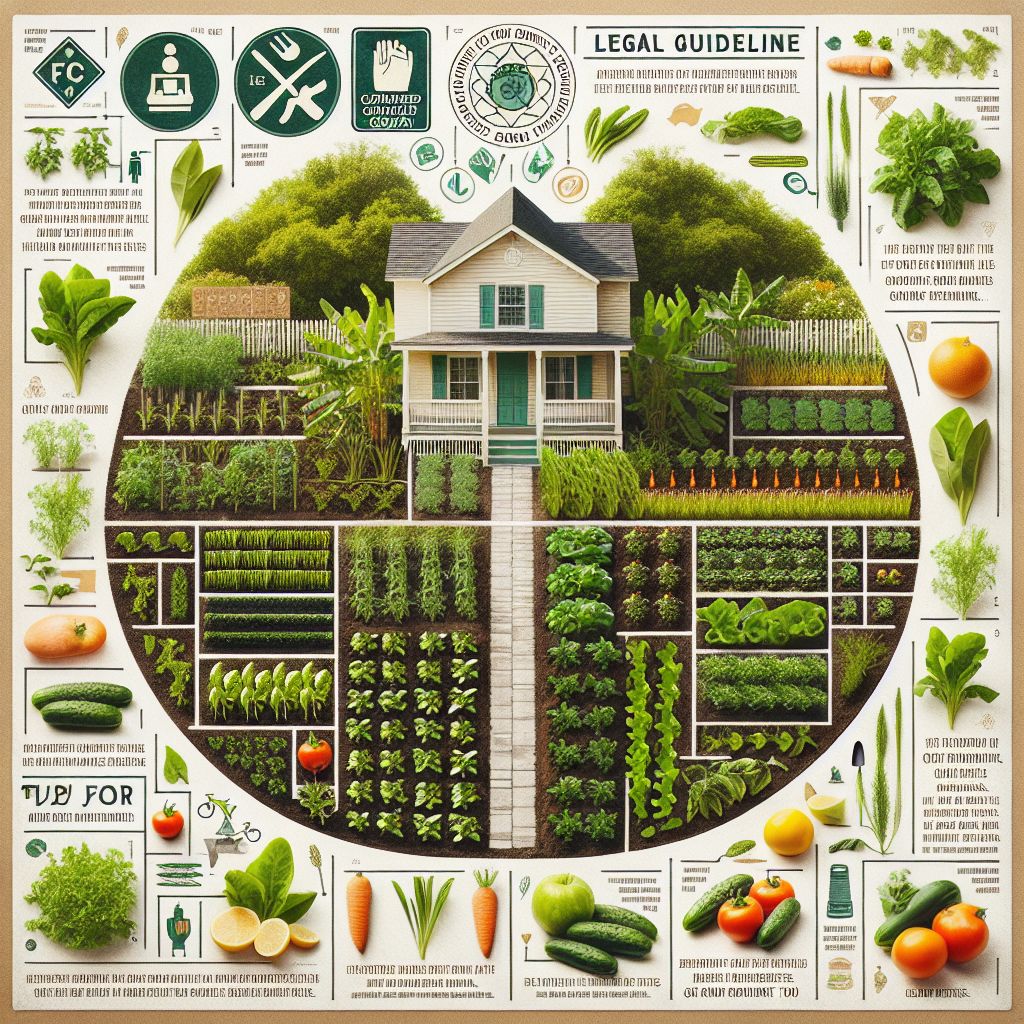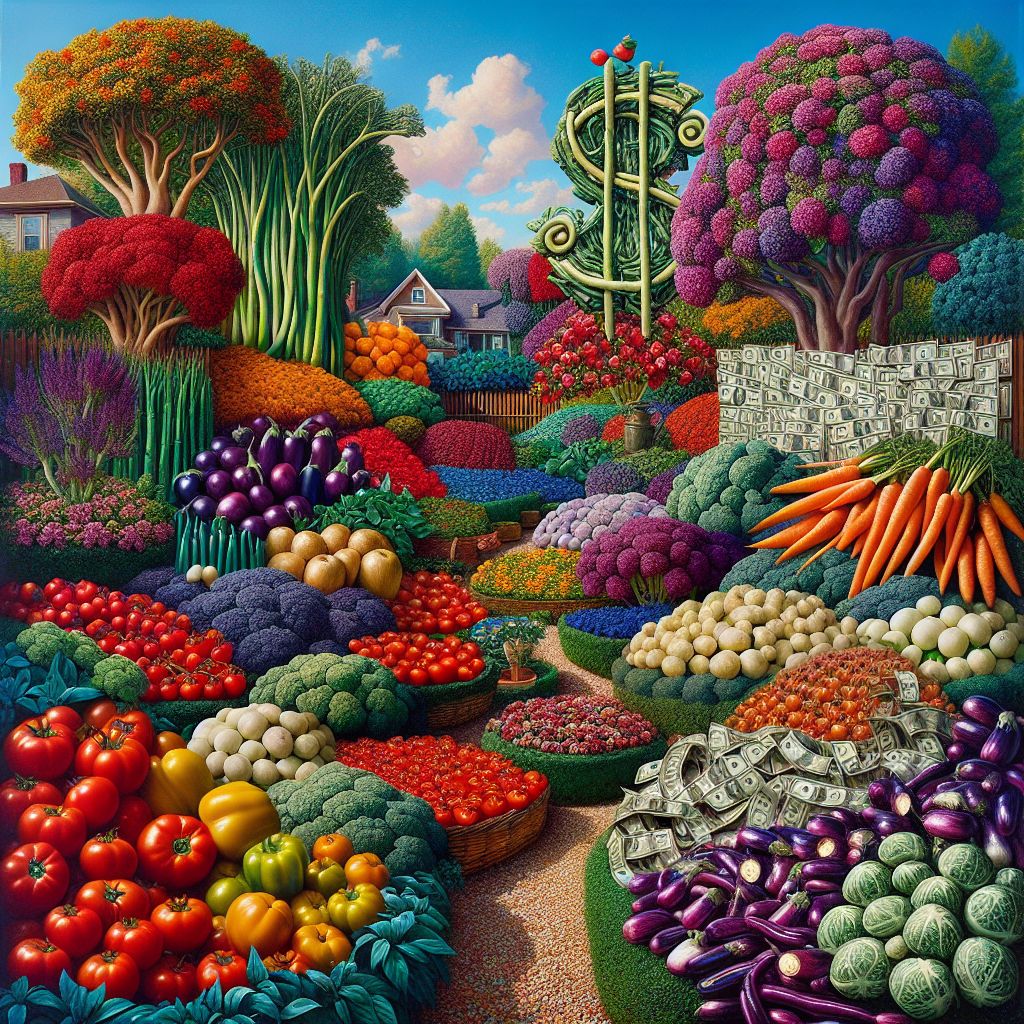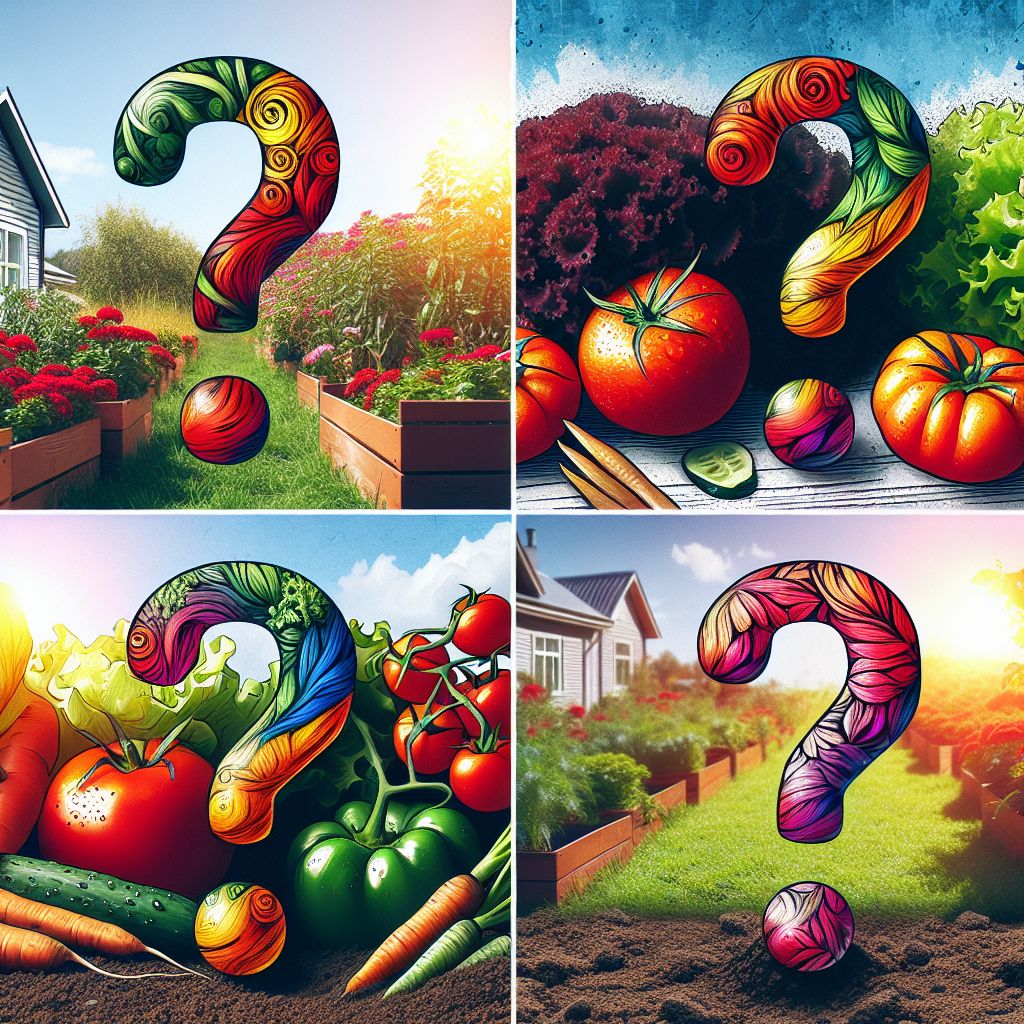
When it comes to cultivating a lush vegetable garden in your Florida front yard, knowledge is as essential as sunlight and water. The first step is understanding the law, which can be as complex as the ecosystem of a well-tended garden. But don’t worry, I’m here to guide you through the maze of regulations and into the bounty of your own homegrown food.
Key Takeaways
- Florida Statute 604.71 allows residents to grow vegetables on their residential property regardless of local ordinances.
- Homeowners associations (HOAs) may have their own rules that could restrict vegetable gardening.
- Understanding your local climate and choosing the right plants is crucial for a thriving garden.
- Designing your garden for both aesthetics and function can help integrate it into your front yard seamlessly.
- Regular maintenance, including proper watering and pest control, is key to a productive vegetable garden.
What’s Legal in Your Garden? Understanding Florida’s Vegetable Gardening Laws
Let’s dig into the dirt of legalities first. As of July 1, 2019, Florida residents have been given the green light to cultivate vegetables on their own property. This is thanks to Statute 604.71, which was established to override any local laws that previously banned front yard vegetable gardens. So, if you’ve been dreaming of turning your lawn into a cornucopia of veggies, the state law’s got your back.
However, there’s a catch. If you’re part of a homeowners association (HOA), they may have rules that put a fence around what you can and cannot do. Some HOAs still prohibit front yard vegetable gardens, so it’s important to check with them before you start planting. If you find yourself up against an HOA rule, don’t lose hope; we’ll discuss ways to work around these restrictions later on.
The Green Light for Greens: Statute 604.71 Explained
Statute 604.71 is pretty straightforward: it prohibits local governments from creating any ordinance that outright bans vegetable gardens on residential properties. This means you can cultivate your garden without fear of fines or forced removal. But remember, this law doesn’t extend to common areas managed by an HOA or to any other private covenants that may apply to your property.
Navigating Homeowners Associations: What You Need to Know
If you’re part of an HOA, it’s crucial to understand their specific rules regarding vegetable gardens. Some may allow them with certain restrictions, such as how much of your yard can be used or what types of structures you can build. If your HOA says no to your garden plans, consider negotiating with them. Present your case with a well-thought-out garden design that enhances the aesthetic of the neighborhood, and be prepared to compromise.
Sowing the Seeds of Success: How to Flourish with Front Yard Veggies
With the legal groundwork laid, let’s focus on how to cultivate a front yard garden that will be the envy of your neighborhood. The key is to create a space that is both productive and beautiful. Start by sketching out a design that incorporates both vegetables and ornamental plants. This approach can satisfy aesthetic concerns and even win over skeptical neighbors or HOA boards.
Designing a Front Yard Garden That Grows With You
When designing your garden, consider front yard vegetable garden legality and guidelines to ensure your garden is not only beautiful but also compliant with local regulations.
- Location: Choose a spot that gets plenty of sunlight — most vegetables thrive with at least six hours of direct sun per day.
- Layout: Organize your plants by height, ensuring taller plants don’t shade out shorter ones, and use paths to allow easy access for maintenance.
- Edibles as Ornamentals: Many vegetables, like rainbow chard or purple kale, are as beautiful as they are tasty. Use them to add color and texture to your landscape.
Remember, your garden should be a reflection of what you love to eat as much as it is a complement to your home’s aesthetic. So go ahead, plant those heirloom tomatoes and fragrant herbs. Not only will they provide fresh produce, but they’ll also give your home a unique, living decoration.
Edible Landscaping: Marrying Beauty with Utility
When you think about landscaping, don’t just think about the ornamental aspect; think about how you can integrate utility with beauty. Edible landscaping is the practice of incorporating food-producing plants into your yard. Imagine picking fresh tomatoes and basil right from your flowerbeds to make a salad for dinner. Not only is this approach practical, but it also creates a dynamic, ever-changing landscape that’s both beautiful and delicious.
Heat Lovers: Veggies That Thrive in Florida’s Climate
Florida’s heat and humidity are a perfect match for certain vegetables that simply flourish under the sun. Here are a few you might consider:
- Tomatoes: A classic favorite, tomatoes love the Florida heat. Choose a variety bred for heat tolerance and stake them well to keep them off the ground.
- Peppers: From sweet bells to fiery habaneros, peppers are not just heat-tolerant; they thrive in it.
- Okra: Okra is almost indestructible in the heat and is a staple in Southern cooking.
- Eggplant: Eggplant loves warm soil and air, making it a perfect fit for Florida gardens.
- Sweet Potatoes: These are more than just a Thanksgiving favorite; they’re a heat-loving tuber that grows well in Florida’s sandy soil.
These plants not only stand up to the Florida heat but also can help shade more delicate herbs and vegetables that you might plant in the same garden bed. It’s all about creating a harmonious ecosystem where each plant supports the others.
Seasonal Selections: What to Plant and When
While Florida’s climate is conducive to year-round gardening, there are optimal times to plant certain vegetables. For a more detailed guide on what to plant and when in Florida, here’s a quick overview:
- Spring: This is the time for tomatoes, peppers, cucumbers, and squash. Get them in the ground early and enjoy a bountiful harvest before the peak summer heat.
- Summer: Focus on heat-tolerant veggies like okra, sweet potatoes, and southern peas.
- Fall: As the heat subsides, it’s ideal for a second planting of spring vegetables, along with carrots, beets, and leafy greens.
- Winter: In Florida’s mildest regions, you can grow cool-season crops like broccoli, kale, and lettuce.
Remember, planting times can vary depending on your specific location in Florida, so it’s a good idea to consult a local planting calendar or extension service for guidance.
References:
https://edis.ifas.ufl.edu/publication/VH021
https://discover.pbcgov.org/coextension/horticulture/pdf/residential/FloridaVegetableGuide.pdf
https://www.reddit.com/r/FloridaGarden/comments/ajcuc3/florida_vegetable_gardening_for_beginners/

Garden to Table: Maximizing Your Harvests
One of the joys of vegetable gardening is the ‘garden to table’ freshness you can’t find in any store. To maximize your harvests, you need to start with good soil. In Florida, that often means amending the sandy soil with compost or other organic matter to improve its water retention and fertility. Also, be vigilant about pests and diseases that thrive in the same heat as your veggies. Regular inspections and organic interventions can keep your plants healthy and productive.
Tips for Abundant Yields in Limited Space
Not everyone has a sprawling yard for gardening, but that doesn’t mean you can’t have an abundant harvest. Here are some tips for getting the most out of a smaller space, including backyard mushroom cultivation which can be a great way to utilize shady areas of your garden.
- Vertical Gardening: Train vining plants like cucumbers and beans up trellises or fences to save space.
- Interplanting: Grow quick-harvest crops like radishes or lettuce in between slower-growing vegetables. They’ll be ready to eat by the time the others need the room.
- Container Gardening: Pots and planters can be a great option for patios or balconies, and many vegetables, like herbs and peppers, thrive in them.
By being strategic about your plant choices and their placement, you can turn even the tiniest of front yards into a productive garden.
Organic Practices: Keeping Your Garden Healthy Naturally
A healthy garden is a productive garden. To avoid chemical pesticides and fertilizers, embrace organic practices:
- Composting: Turn kitchen scraps and yard waste into nutrient-rich compost to feed your plants.
- Natural Pest Control: Attract beneficial insects, like ladybugs, that will eat harmful pests.
- Crop Rotation: Don’t plant the same vegetable in the same spot year after year to avoid depleting the soil and encouraging disease.
These practices not only keep your garden healthy but also protect the environment and your family from harmful chemicals.
The Root of the Matter: Tangible Benefits of Front Yard Gardens
There’s more to a front yard vegetable garden than the harvest. It can improve your health, reduce your carbon footprint, and even save you money. Besides that, the act of gardening itself is a stress-reliever and a form of physical exercise.
Most importantly, a front yard garden transforms your living space. It’s a conversation starter with neighbors and a way to contribute to a greener, more sustainable community. And let’s not forget the sheer satisfaction of eating food you’ve grown yourself. There’s nothing quite like it.
- Health benefits from fresh, pesticide-free produce
- Reduction in grocery bills
- Increased property appeal and potential value
- Environmental benefits from reduced carbon footprint
- Community building and education opportunities
From Aesthetic Appeal to Ecosystem Services
Your front yard garden isn’t just for show; it’s a crucial part of the local ecosystem. By planting a variety of vegetables, you’re creating a habitat for pollinators like bees and butterflies. You’re also contributing to better air quality and reducing the urban heat island effect. These “ecosystem services” are invaluable, and they start right in your front yard.
Community and Well-being: The Social Perks of Public Produce
A vegetable garden can become a focal point for community engagement. Sharing your harvest with neighbors fosters a sense of community and can inspire others to start their own gardens. It’s also an educational tool for children, teaching them where food comes from and the importance of environmental stewardship.

FAQs
Are there any vegetables I can’t grow in my Florida front yard legally?
Under Florida law, you’re allowed to grow vegetables in your front yard without restriction from local governments. However, certain plants that are classified as invasive species should be avoided to protect local ecosystems. Always check with your local extension service to ensure the plants you choose are suitable for the area.
How can I garden if my HOA is against front yard vegetable gardens?
If your HOA has restrictions on front yard vegetable gardens, try to work within their guidelines. Use decorative planters or design a garden that incorporates both ornamental and edible plants in an aesthetically pleasing way. You can also request a review of the rules or propose an amendment. Sometimes, a well-presented case can lead to changes that benefit the entire community.
What are some creative ways to integrate vegetables into my front lawn?
Consider using raised beds with attractive borders, incorporating vegetable plants into existing flower beds, or using trellises to create living green walls. Another idea is to create a theme garden, such as a pizza garden with tomatoes, peppers, and herbs, that is both fun and functional.
When is the best time to start a vegetable garden in Florida?
The best time to start a vegetable garden in Florida depends on the crop. Generally, cool-season crops should be planted in the fall, while warm-season crops do best when planted in the spring after the last frost. Consult a local planting calendar for the best planting times for specific vegetables in your area.
Can I sell the produce from my front yard garden?
Yes, you can sell produce from your front yard garden, but there may be local regulations that you need to follow. These could include obtaining a permit or following specific guidelines for home-based food businesses. Check with your local government to ensure you comply with any necessary requirements.




Leave a Reply